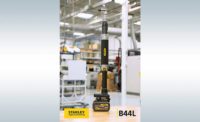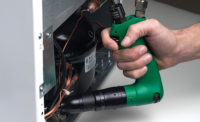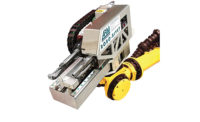Error proofing, quality control and flexibility are essential on today’s assembly lines. As a result, manufacturers are increasingly investing in DC electric fastening tools. These tools allow engineers to adjust tool speed to match various applications and control more aspects of the fastening process, including key parameters such as torque and angle.
“Twenty years ago, DC electric tools were reserved for ‘safety-critical’ joints, like air bags or seat-to-floor connections,” says Len Demchak, vice president of product development and technology at AIMCO. “Later, use of the tools was expanded to warranty-related jobs. Today, it’s about improving quality across the board. Companies are getting rid of air tools and simple shut-off tools, and they’re replacing them with higher end DC systems.”
The need for data collection and connectivity is also fueling increased investment in DC electric tools. “The big trend with electric tools is line controls and data collection. It’s all about connectivity and ‘Industry 4.0,’” says Demchak. “Manufacturers even want to collect data from simple mechanical click wrenches.”
One Controller, Many Tools
From a mechanical standpoint, DC electric tools haven’t changed much in the past 10 years. Brushless motors, high-cycle gearing and high-accuracy torque transducers are standard today. What have changed are the controllers. They have become smaller, more powerful, and more connected.
For example, the AcraDyne Gen IV Ace controller from AIMCO allows assemblers to simultaneously control a variety of tools with just one cable. The controller is compatible with all of AIMCO’s transducerized tools (AcraDyne DC and battery-powered tools, and Uryu DC and pneumatic tools), which have a torque capacity from 1 to 12,000 newton-meters.
As the core of the modular AcraDyne DC system, the controller enables engineers to work in program mode with one tool, review real-time curves on another tool, and watch diagnostics on a third. The unit features browser-based programming, so engineers can receive data on a PC, tablet, smartphone, or any other web-capable device. Its comprehensive software allows for easy adding and editing of parameter settings. In addition, the controller provides one common communication protocol for global data collection, line controls and fieldbus platforms
The controller has a bright LED display, allowing assemblers to easily view torque, angle, bolt count, parameter set, and job and sequence information— even from a distance. An optional 7-inch touch-screen graphical display provides real-time graphing for application review. The same software that runs on a PC for programming and data download runs on the display.
The controller has four USB ports, so engineers can back up, restore and update software or download assembly data and curves. It also has two Ethernet ports, so it can interface with two networks simultaneously for separate line control and data collection. There’s also 16 assignable I/O (eight in and eight out) and a serial port for data string output, serial protocols, bar code scanners and printers. The controller supports CC-Link, DeviceNet, Profinet, Profibus and all platforms offered by Anybus.
The device can store 20,000 run-downs, including the curves, and it has a 5,000-record event log. Engineers can also program calibration and service charts.
IR’s New Controller
In February, Ingersoll Rand introduced the INSIGHTqc controller. The device powers Ingersoll Rand’s QE Series and QM Series DC electric assembly tools and collects data that manufacturers can act on to improve production. The controller stores up to 50,000 records of cycle data and 50,000 tightening traces onboard the device—one of the largest storage capacities of any controller on the market and 50 times more than the previous Ingersoll Rand model.
The INSIGHTqc controller is simple to set up and integrate into assembly operations, and it can be connected to multiple devices. Fastening data is saved on an internal solid-state drive, and the controller can be connected to a network to save the data on a plant’s server. Metrics and analytics are protected even if a network connection is dropped and can be studied any time for quality control.
Equipped with four onboard USB ports, the controller can support up to four plug-and-play accessories or devices, such as a bar code scanner or smart socket tray. Operators can also save time and increase productivity with an integrated help system.
The controller’s web-based software is compatible with smartphones, tablets and other Internet-based devices. Integrated logic controls facilitate integration on the assembly line. It is also easy to upgrade the controller’s hardware and software to meet any tightening control requirements.
Onboard diagnostics and integrated statistical process controls are represented visually, so manufacturers can quickly identify and correct fastening errors. The controller is also equipped with preventative maintenance alarms and configurable email alerts.
Desoutter’s Modular Hub
Desoutter Industrial Tools has just introduced the CONNECT, a modular, wireless communication hub for fastening tools. The device provides a single point of connection for communications between a factory network and up to 20 tools, reducing cost of ownership and simplifying installation for easier line rebalancing. The hub is also designed to connect with error-proofing accessories, such as stack lights, smart socket trays, operator controls, and remote user interfaces.
Initially, the hub will only be for Desoutter’s cordless tools, but the product will eventually be expanded to include corded tools and torque wrenches, says Russ Hughes, threaded fastening technology marketing manager at Desoutter.
Two versions are available. CONNECT-W has an embedded wireless access point and can communicate with up to 10 fastening tools. CONNECT-X requires an external wireless access point, but can communicate with up to 20 tools. Tools are easily paired with any hub via RFID technology, so tools can be added or moved on a line without disruption.
This compact device—it occupies just 0.13 cubic feet of space—can be installed anywhere in an assembly plant: at a workstation, at the end of the line, on a manager’s desk, or even in the server room.
With feature management, engineers can fine-tune each tightening unit according to the requirements for each workstation. A feature can be activated for one tightening unit, but not on another.
“The idea is to pay only for what you need,” Hughes explains. “You don’t want to pay for everything when you’re only using a small portion of the functionality.”
Software is available for tightening strategies, assembly process management, key performance indicators, and traceability.
Simplified Maintenance
Stanley Engineered Fastening recently revamped its line of high-end DC electric fastening tools. The company’s EB Series of corded tools have been designed to be more ergonomic, more durable and easier to maintain.
A new high-speed motor provides smooth motion and a high power-to-weight ratio, and new high-speed, low-friction gearing minimizes noise, vibration and heat for better ergonomics.
The tools feature modular construction to lower the mean time to repair. Common components reduce complexity and cost for maintenance. The entire tool line has seven motor sizes, five modular gear sets, and seven angle heads that are field-repairable with matched replacement gear sets.
The handle and lever assembly is common to all handheld tools. A noncontact optical switch under the start lever increases mean time between failures by eliminating mechanical or magnetic switches, which wear out over time. Increased lever length, recessed mounting and “flush to handle” activation improve fit to the operator’s hand.
A multifunction button on the handle can select from two job setups and other process functions. The button requires minimal activation pressure, but a raised ring prevents accidental triggering. High, low and OK lights indicate fastening status with 360-degree viewing.
Tools are available in fixtured, in-line, pistol-grip, and angle-head models. The latter are also available in tubenut, crowfoot, flush angle (for accessing narrower spaces), and hold-and-drive versions. Hold-and-drive tools simultaneously hold the bolt while the nut is tightened. A formed end on the bolt interfaces with a mating tang or bit to prevent bolt rotation. In addition, the gear case on angle-head tools can be lengthened to extend the reach of the tool.
Stanley’s new controller provides a common interface for a variety of tools: handheld, corded tools; handheld, cordless tools; and fixtured spindles. The controller connects with Stanley’s EB Series corded tools, B series cordless tools, E Series corded tools, and legacy EA Series and EC Series tools.
The Alpha Toolbox, included with every QB Series controller, is used to program tightening strategies, collect cycle and traceability data, and perform online diagnostics.
Engineers can take advantage of various preprogrammed fastening strategies and “smart steps.” Each strategy consists of a complete set of parameters to control and audit torque, angle, time, speed and power. Each strategy may advance to the next, invisible to the operator, or pause the tool briefly to manage direction changes, multiple spindle synchronization, or relaxation and crosstalk effects.
For example, “Slow Seek” directs the tool to rotate more slowly at first to allow the socket to fully engage the flats on the fastener before full rotation and fastening. “Self Tap” allows the tool to compensate for high prevailing torque applications before final tightening. “Adaptive Tightening Control” slows the tool’s speed as torque rises. This prevents sudden downshifting, which helps ease operator fatigue and reduce torque reaction.






